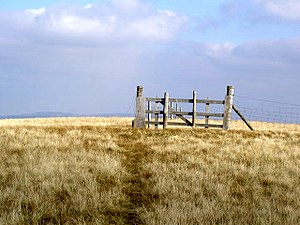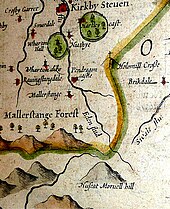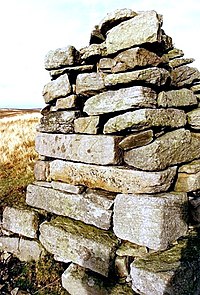Hugh Seat: Difference between revisions
Created page with "{{Infobox hill |name=Hugh Seat |county 1=Westmorland |county 2=Yorkshire |picture=Hugh Seat (IanGreig).jpg |picture caption=The summit of Hugh Seat |os grid ref=SD809991 |lati..." |
No edit summary |
||
| (One intermediate revision by one other user not shown) | |||
| Line 11: | Line 11: | ||
|range=Pennines | |range=Pennines | ||
}} | }} | ||
'''Hugh Seat''' is a mountain amongst the [[Pennines]] whose summit stands on the border between [[Westmorland]] and the [[ | '''Hugh Seat''' is a mountain amongst the [[Pennines]] whose summit stands on the border between [[Westmorland]] and the [[North Riding of Yorkshire]]. It is also at the watershed between [[Mallerstang Common]] in Westmorland to the west and [[Angram Common]] and the [[Yorkshire Dales]] to the east. | ||
Hugh Seat is a high point above Black Fell Moss, an extensive area of peat bog drained by Red Gill Beck, which is the source of the [[River Eden, Cumberland and Westmorland|River Eden]]. At this watershed between east and west two of the great rivers of Yorkshire great rivers, the [[River Ure|Ure]] and the [[River Swale|Swale]], also rise just half a mile from the Eden: the Eden flows west and ultimately to the [[Irish Sea]], while the waters of the Ure and Swale flow west, ultimately to the [[North Sea]]. | Hugh Seat is a high point above Black Fell Moss, an extensive area of peat bog drained by Red Gill Beck, which is the source of the [[River Eden, Cumberland and Westmorland|River Eden]]. At this watershed between east and west two of the great rivers of Yorkshire great rivers, the [[River Ure|Ure]] and the [[River Swale|Swale]], also rise just half a mile from the Eden: the Eden flows west and ultimately to the [[Irish Sea]], while the waters of the Ure and Swale flow west, ultimately to the [[North Sea]]. | ||
| Line 17: | Line 17: | ||
Although it has a relatively small prominence, having several other high points nearby (and is therefore classified as a 'sub-Hewitt' or a 'Nuttall' but not a 'Marilyn'). Hugh Seat nevertheless rises conspicuously above the source of the dale of the River Eden. | Although it has a relatively small prominence, having several other high points nearby (and is therefore classified as a 'sub-Hewitt' or a 'Nuttall' but not a 'Marilyn'). Hugh Seat nevertheless rises conspicuously above the source of the dale of the River Eden. | ||
[[File:SpeedeMap1610 - Westmorland, south-east extract.jpg|left|thumb| | [[File:SpeedeMap1610 - Westmorland, south-east extract.jpg|left|thumb|170px|Mallerstang (showing "Huseat Morvel hill"); from John Speede's 1610 map of Westmorland]] | ||
[[File:HughSeat ladypillar.jpg|right|thumb|200px|Lady Anne's Pillar (1664)]] | [[File:HughSeat ladypillar.jpg|right|thumb|200px|Lady Anne's Pillar (1664)]] | ||
The old name for this peak was Hugh Seat Morvill or sometimes Morvil Hill,<ref>M. Ffinch, ''The Howgills and the Upper Eden Valley'', Hale, 1982 (page 22)</ref> (and Daniel Defoe confuses it with [[Wild Boar Fell]] in his "Tour").<ref>{{Defoe|10}}</ref> | The old name for this peak was Hugh Seat Morvill or sometimes Morvil Hill,<ref>M. Ffinch, ''The Howgills and the Upper Eden Valley'', Hale, 1982 (page 22)</ref> (and Daniel Defoe confuses it with [[Wild Boar Fell]] in his "Tour").<ref>{{Defoe|10}}</ref> | ||
Latest revision as of 18:07, 24 September 2017
| Hugh Seat | |||
| Westmorland, Yorkshire | |||
|---|---|---|---|
 The summit of Hugh Seat | |||
| Range: | Pennines | ||
| Summit: | 2,260 feet SD809991 54°23’15"N, 2°17’38"W | ||
Hugh Seat is a mountain amongst the Pennines whose summit stands on the border between Westmorland and the North Riding of Yorkshire. It is also at the watershed between Mallerstang Common in Westmorland to the west and Angram Common and the Yorkshire Dales to the east.
Hugh Seat is a high point above Black Fell Moss, an extensive area of peat bog drained by Red Gill Beck, which is the source of the River Eden. At this watershed between east and west two of the great rivers of Yorkshire great rivers, the Ure and the Swale, also rise just half a mile from the Eden: the Eden flows west and ultimately to the Irish Sea, while the waters of the Ure and Swale flow west, ultimately to the North Sea.
Although it has a relatively small prominence, having several other high points nearby (and is therefore classified as a 'sub-Hewitt' or a 'Nuttall' but not a 'Marilyn'). Hugh Seat nevertheless rises conspicuously above the source of the dale of the River Eden.


The old name for this peak was Hugh Seat Morvill or sometimes Morvil Hill,[1] (and Daniel Defoe confuses it with Wild Boar Fell in his "Tour").[2]
Near the summit there is a column of cut stones, known as "Lady's Pillar", and the inscription AP1664 can just be made out - for Anne Pembroke, Lady Anne Clifford's married name. The pillar was erected in 1664 to commemorate Sir Hugh de Morville, Lady Anne's predecessor as Lord of the Manor of Mallerstang. (Sir Hugh was one of the four knights responsible for the murder of Archbishop Thomas Beckett in Canterbury Cathedral in 1170.)
The border between the two counties is marked near the summit by a fence, which is intended to stop sheep which are "heafed" (trained to stay in a certain area without the need for fences) straying beyond their allotted common land.
There are extensive views from the summit: to the south-east the view looks to Cotterdale and Wensleydale; north-west to Gregory Chapel; and west to Mallerstang and Wild Boar Fell. This rugged terrain between Great Shunner Fell and Wild Boar Fell, (part of what David Bellamy has called "the last wilderness in England"), is too inaccessible to be well known by tourists, but it is a favourite route for many walkers.[3]